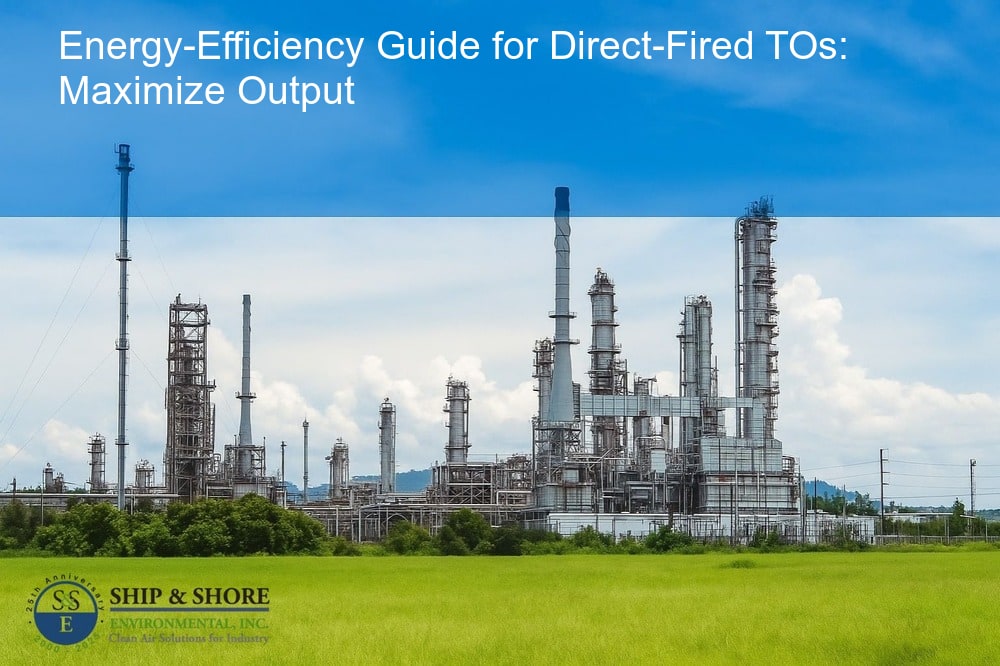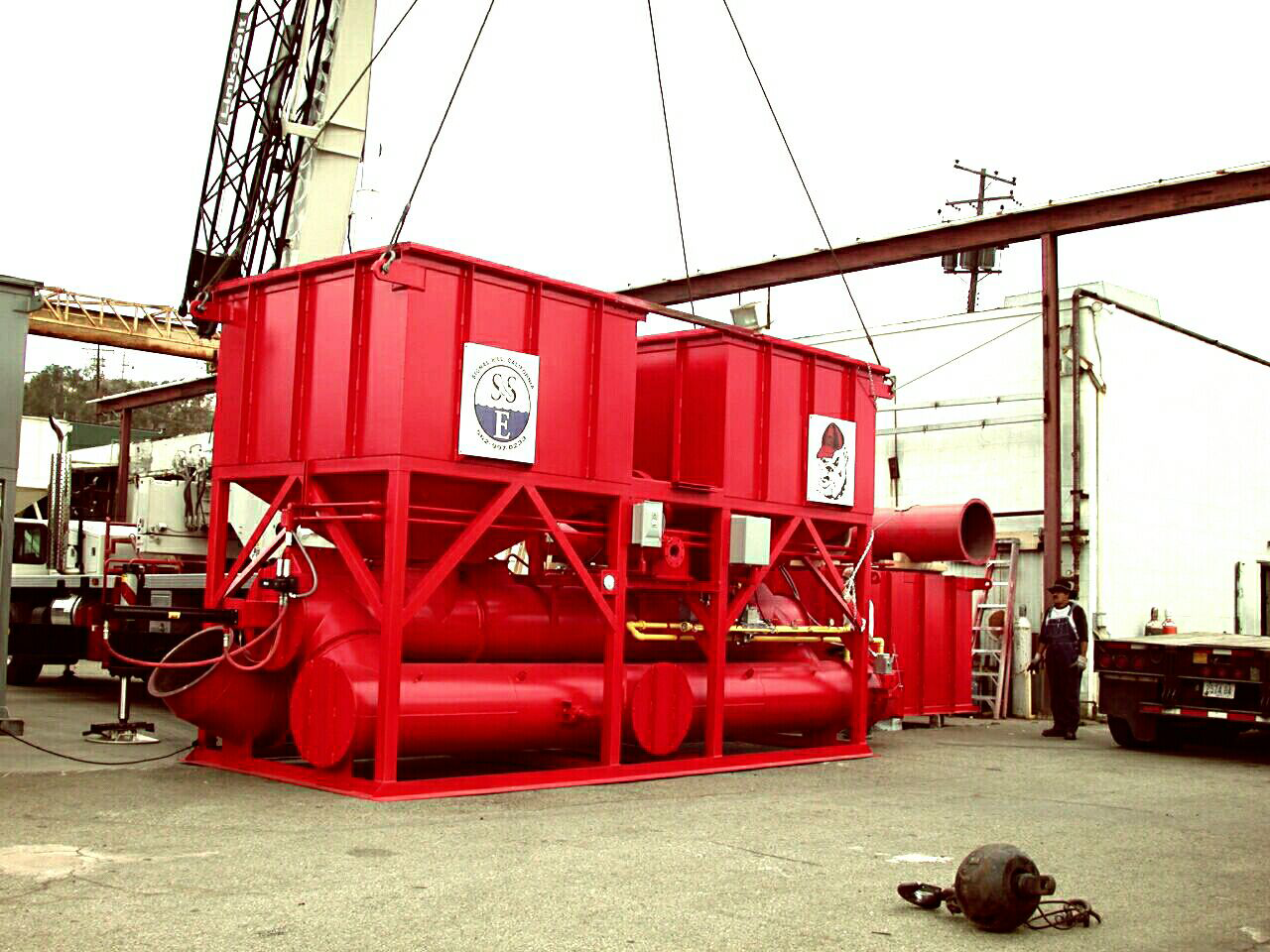
Ultimate Energy-Efficiency Guide for Direct-Fired TOs
June 25, 2025 5:17 amUnderstanding Direct-Fired Thermal Oxidizers
Welcome to our comprehensive energy-efficiency guide for direct-fired TOs. Direct-fired thermal oxidizers (TOs) are critical in managing emissions, particularly in industries with volatile organic compounds (VOCs) and hazardous air pollutants (HAPs). As leaders in providing emission control solutions, we at Ship & Shore Environmental, Inc. recognize the significant role these systems play in improving air quality and maintaining regulatory compliance. Ensuring that these systems operate efficiently is essential not only for environmental sustainability but also for reducing operational costs.
The Importance of Energy Efficiency in Direct-Fired TOs
Energy efficiency in direct-fired TOs translates to lower operational costs, reduced fuel consumption, and minimized environmental impact. By optimizing energy use, we can help industries achieve their sustainability goals while also enhancing the overall performance of their emission control systems. Efficient TOs can convert pollutants into less harmful emissions using less energy, which is both environmentally and economically beneficial.
Investing in energy-efficient TOs can result in significant cost savings over time. These savings arise from reduced energy consumption, lower maintenance costs, and potential incentives or credits associated with operating environmentally conscious technologies. As energy prices continue to rise and sustainability becomes a key focus for industries worldwide, energy-efficient TOs stand out as a smart and proactive investment.
Setting the Stage: Basic Principles behind Direct-Fired TOs
To appreciate the benefits of energy-efficient direct-fired TOs, it’s important to understand their basic operating principles. Thermal oxidizers work by heating polluted air to a high temperature, causing chemical reactions that convert harmful pollutants into harmless gases, primarily carbon dioxide and water vapor. Direct-fired TOs, specifically, use a direct flame to achieve these high temperatures, ensuring efficient conversion of pollutants.
The efficiency of direct-fired TOs relies on various factors, including combustion temperature, residence time (the duration the pollutants stay in the high-temperature environment), and turbulence (the mixing of air and pollutants). By optimizing these factors, we can significantly enhance the energy efficiency of the system. Advanced control systems and regular maintenance are crucial in ensuring that these parameters are consistently optimized for peak performance.
We hope this guide provides you with valuable insights into how direct-fired TOs function and why energy efficiency is vital. In the following sections, we’ll explore the components that contribute to energy efficiency, real-world applications, and emerging trends that are shaping the future of these essential systems.
Exploring Direct-Fired TOs and Their Role in Energy Efficiency
Direct-fired thermal oxidizers (TOs) play a pivotal role in controlling air pollution and ensuring regulatory compliance in industrial processes. These systems are designed to destroy volatile organic compounds (VOCs) and other hazardous air pollutants (HAPs) by combusting them at high temperatures. While their primary function is to reduce emissions, addressing energy efficiency in direct-fired TOs is equally crucial. By minimizing energy consumption, we not only reduce operational costs but also contribute to environmental sustainability. Thus, an energy-efficiency guide for direct-fired TOs is indispensable.
Key Components that Contribute to Energy Efficiency in Direct-Fired TOs
Understanding the key components of direct-fired TOs is essential for optimizing their energy efficiency. Several elements influence the overall energy consumption of these systems, including the burner, the combustion chamber, heat recovery systems, and control mechanisms. Each component must work harmoniously to maximize performance while minimizing energy usage.
Firstly, the burner is a crucial component, as its efficiency directly impacts the amount of fuel required. High-efficiency burners ensure complete combustion while reducing fuel consumption. Secondly, the combustion chamber must be designed to maintain optimal temperatures, ensuring maximum destruction of pollutants without excessive energy use. Insulation and proper airflow management can significantly enhance the chamber’s efficiency.
Additionally, incorporating heat recovery systems can dramatically improve energy efficiency. Heat exchangers capture waste heat from the exhaust gases and use it to preheat the incoming air or other process streams. This process reduces the total energy required for combustion. These systems not only enhance the thermal efficiency of the TO but also lower operational costs.
Lastly, advanced control systems enable real-time monitoring and adjustments, ensuring the TO operates at peak efficiency. By precisely controlling the air-fuel ratio, temperature, and flow rates, we can achieve optimal combustion while minimizing energy consumption. Implementing these control mechanisms is vital for maintaining consistent performance and energy efficiency.
Case Study: Real-World Applications of Energy-Efficient Direct-Fired TOs
In examining the practical applications of energy-efficient direct-fired TOs, we consider various industries that have successfully implemented these systems. For instance, the chemical manufacturing sector often deals with high VOC emissions, necessitating robust air pollution control solutions. By employing energy-efficient direct-fired TOs, companies have reported substantial reductions in energy usage and operational costs.
- A major chemical plant implemented advanced heat recovery systems, leading to a 30% decrease in fuel consumption.
- A pharmaceutical company optimized its combustion chamber insulation and airflow management, resulting in a 25% reduction in energy usage.
- An electronics manufacturer integrated cutting-edge control systems, achieving a 20% increase in overall energy efficiency.
These real-world examples demonstrate the tangible benefits of adopting energy-efficient technologies in direct-fired TOs. Furthermore, these successes underscore the importance of continuous innovation and adaptation to industry-specific needs.
By exploring these components and real-world applications, we gain valuable insights into achieving energy efficiency in direct-fired TOs. This guide aims to provide practical solutions and best practices for optimizing the performance of these systems while minimizing energy consumption.
Did you know? Energy-efficient Direct-Fired Thermal Oxidizers (TOs) not only curb industrial emissions but also significantly reduce fuel consumption, cutting operational costs.
Achieving Greater Energy Efficiency with Direct-Fired TOs: An Overview
As pioneers in the field, we at Ship & Shore Environmental, Inc. understand that achieving energy efficiency in direct-fired thermal oxidizers (TOs) is not just a goal, but a necessity. Our journey in creating the Energy-Efficiency Guide for Direct-Fired TOs has shown us the vital role these systems play in reducing operational costs, conserving energy, and minimizing environmental impact. By focusing on the core components and principles driving these systems, we can unlock a level of efficiency that benefits both our clients and the planet.
Future Trends: How Innovations Are Improving Energy Efficiency in Direct-Fired TOs
Looking ahead, the landscape of direct-fired thermal oxidizers is set to evolve with multiple innovative trends shaping the future. Advances in materials science are paving the way for more durable and heat-resistant components, while smart technologies are enabling real-time monitoring and autonomous adjustments to ensure optimal performance. These innovations, aligned with our expertise, will make TOs more efficient, reliable, and sustainable. Companies that integrate these advancements can expect to see significant improvements in their energy use, emissions, and operational expenditures.
Final Thoughts: The Importance of Regular Maintenance in Optimizing Direct-Fired TO’s Energy Efficiency
While new technologies are exciting, regular maintenance remains a cornerstone of any effective energy-efficiency strategy. Routine inspections, timely repairs, and system upgrades are critical to maintaining peak operational performance. At Ship & Shore Environmental, Inc., we advocate for a proactive approach, ensuring that every component of a direct-fired TO is functioning optimally. By adhering to these maintenance practices, we help our clients sustain energy efficiency, reduce downtime, and extend the lifespan of their equipment.
In essence, achieving and maintaining energy efficiency in direct-fired thermal oxidizers demands a holistic approach. From understanding the basic working principles and key components to staying abreast of future innovations and committing to regular maintenance, the journey is multifaceted but absolutely within reach. We invite you to explore our case studies to see real-world applications of these principles in action. By integrating the insights and strategies outlined in our Energy-Efficiency Guide for Direct-Fired TOs, businesses can look forward to a sustainable and cost-effective future.
FAQ
What is a direct-fired thermal oxidizer and how does it work?
A direct-fired thermal oxidizer (TO) is an industrial combustion system designed to destroy hazardous air pollutants, volatile organic compounds, and odorous emissions that are often byproducts of industrial processes. It operates by drawing contaminated air into a combustion chamber where it is heated to a high temperature until the pollutants oxidize, turning them into less harmful substances like carbon dioxide and water vapor. This process is not only critical for meeting environmental regulations but, when optimized, can greatly enhance energy efficiency.
Why is energy efficiency important in direct-fired TOs?
Energy efficiency in direct-fired TOs is crucial as it directly correlates to operational costs and environmental impact. Efficient systems require less fuel to achieve the desired level of pollutant destruction, leading to lower operational costs. Furthermore, optimizing energy use in these systems helps reduce the carbon footprint, aligning with global efforts to combat climate change. Therefore, maintaining an energy-efficient operation is not just economically sound, it’s a responsible environmental practice.
What components are key to enhancing energy efficiency in direct-fired TOs?
Ket components that contribute to energy efficiency in direct-fired TOs include heat recovery systems, proper insulation, combustion control systems, and optimized burner designs. Each of these elements plays a critical role in minimizing heat loss, improving fuel combustion efficiency, and ultimately reducing the amount of fuel required. Integrating these components effectively can lead to a substantial increase in overall system efficiency.
How do regular maintenance and inspections contribute to TO energy efficiency?
Regular maintenance and inspections are paramount for ensuring that a direct-fired TO operates at its peak efficiency. Through routine check-ups, any issues such as leaks, component wear, or suboptimal combustion can be identified and addressed promptly. Moreover, systematic maintenance can prevent unexpected downtimes, extend the equipment’s life, and maintain consistent energy-saving performance. Adhering to a proactive maintenance schedule is a practical approach that supports sustained energy efficiency.
What future innovations are anticipated to improve the energy efficiency of direct-fired TOs?
In the near future, we anticipate innovations in materials technology and smart system controls to significantly enhance the energy efficiency of direct-fired TOs. Advancements in heat-resistant materials can lead to better insulation and reduced thermal losses. Moreover, the integration of smart sensors and artificial intelligence will enable real-time performance adjustments and predictive maintenance, ensuring that TOs operate at maximum efficiency while offering improved reliability and lower energy costs.
Categorised in: Blog

